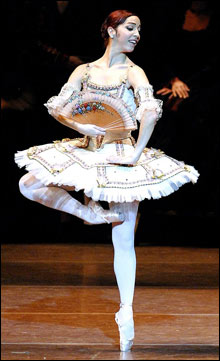
A FOR ATTITUDE: And the Gibraltar award to Lorna Feijóo for rock-steady relevé-passé work.
|
Don Quixote has been a watershed work for Boston Ballet. In 1982, the 44-year-old Rudolf Nureyev brought his version of the 1869 Marius Petipa classic to the still fledgling company and danced Basilio himself; the production and the subsequent tour of the US and Mexico launched the Ballet on the road to becoming one of America’s top companies. In 1989, local girl Jennifer Gelfand, who’d been puppet Kitri in that 1982 Quixote, left her seat in the audience to dance Kitri/Dulcinea opposite Fernando Bujones’s Basilio after star Laura Young injured herself during the performance; Gelfand was invited to join the company as a soloist and was promoted to principal the following year. The opening-night Kitri/Dulcinea in the 2000 production, Aleksandra Koltun, tore an Achilles’ tendon as she was jetéeing down the line of Dryads toward the end of the vision scene; Arthur Leeth carried her off, Don Quixote at last embracing his Dulcinea, and Larissa Ponomarenko went on in her place. The company’s most recent production, in 2003, saw Gelfand give her farewell performance, going out as she began, only 14 years wiser and better. The current revival is no watershed; it comes closer to treading water.
The heart of any traditional Don Quixote (George Balanchine’s is an altogether different creature) is the act two vision scene, where three apotheoses of Woman present themselves to the lovelorn knight: the Queen of the Dryads, a kind of Lilac Fairy or Myrtha, mentoring and even maternal; Amor, a Cupid figure, tiny and teasing; and dream girl Dulcinea. They could be the Three Ages of Woman as they dance out their variations in his vision of love. In Cervantes’ novel, Dulcinea is the noble name that our hero gives to the country girl he loves (in secret, of course); in the ballet, the incarnation of Dulcinea is innkeeper’s daughter Kitri, but she’s in love with barber Basilio, and they act out what Don Quixote can only imagine. The plot echoes that of La Fille Mal Gardée: Basilio has no money, and Kitri’s father wants to marry her off to a rich but feckless suitor. Don Quixote, intuiting that Basilio is his stand-in, intervenes to compel dad to let his daughter marry for love; then he continues on in his endless quest for the Ideal.
The snag in this story is that, whereas in Fille Lise’s mother is a terror and a real obstacle to her marriage to Colas, in Quixote innkeeper Lorenzo is a pussycat and the outcome so obvious that even the mystifying mime of Basilio’s fake suicide (the idea seems to be that Kitri will wed Gamache if she’s allowed to marry her “dying” lover first, whereupon Basilio makes a miracle “recovery”) doesn’t matter. After the first act in Barcelona, where Lorenzo gives his consent to Gamache and not Basilio and there’s lots of spirited dancing, Kitri and Basilio flee and are pursued to a Gypsy camp, where there’s more spirited dancing and Don Quixote has his windmill misadventure, which leads to the vision scene. The third act finds everybody back at a tavern in town: Basilio pulls his suicide trick, Lorenzo gives in, Gamache challenges the interfering Don Quixote to a duel and gets his wig pulled off, and there’s a Gypsy wedding with yet more spirited dancing — so much so that, in the Nureyev version, they’re still at it as the curtain falls.
Many great ballets (and operas, for that matter) have survived skeletal plotting, but the Nureyev Quixote just plain thumbs its nose at narrative. The title character is all dither and dodder, with gestures big enough to be read at the back of the Wang’s (unoccupied) second balcony. Sancho Panza, in the novel a farmer turned squire, is Cervantes’ voice of both reason and stomach; in the ballet he’s all stomach and mostly cipher. The first act shows toreador Espada and the Street Dancer (Mercedes in some versions) getting it on, but at the tavern he ignores her to dance with Kitri’s two Friends, and then after a steamy fandango with her at the wedding, he winds up with one of the Friends and she gets the Maid of Honor. That’s right, Kitri’s Friends, her confidantes and co-conspirators, are passed over for a total stranger with, what, better jetées? Espada and the Street Dancer should echo Basilio and Kitri in hoofing out their own model of love, yet another incarnation of Don Quixote’s vision. Instead it’s one wedding and a lot of pick-ups, with Lorenzo snaring Kitri’s other Friend.
ADVERTISEMENT
 |